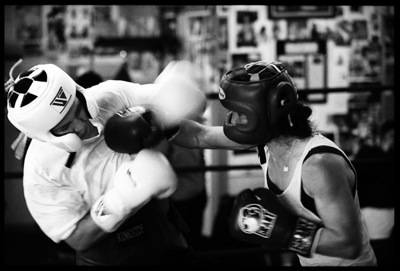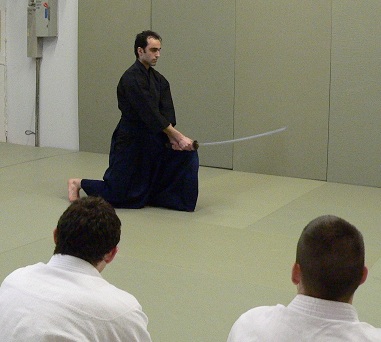How to Train the Use Adrenaline for Martial Arts & Self-Defense
 Produced by the adrenal glands in our body, adrenaline is released when the body experiences high-stress mental or physical situations. It stimulates a variety of bodily functions, including increased heart rate, increased blood to muscles and increased oxygen flow to the lungs, etc. It can be used to increase your performance in sport or self-defense, making you faster, stronger and less affected by pain. It can also enable you to process information while taking actions at a rapid rate, making you more responsive to threats. These reactions, however, are not a given. Everyone has different reactions to adrenaline and the stressful situations that causes its flow. This article explores these reactions and how to train yourself to have more useful reactions for martial arts and self-defense. (more…)
Produced by the adrenal glands in our body, adrenaline is released when the body experiences high-stress mental or physical situations. It stimulates a variety of bodily functions, including increased heart rate, increased blood to muscles and increased oxygen flow to the lungs, etc. It can be used to increase your performance in sport or self-defense, making you faster, stronger and less affected by pain. It can also enable you to process information while taking actions at a rapid rate, making you more responsive to threats. These reactions, however, are not a given. Everyone has different reactions to adrenaline and the stressful situations that causes its flow. This article explores these reactions and how to train yourself to have more useful reactions for martial arts and self-defense. (more…)
Size/Strength vs Technique vs Spirit in the Martial Arts
Have you ever gotten frustrated at being unable to apply a joint lock, do a throw, or get good shots in when sparring against someone much bigger or stronger than you? You’re not alone. Many people come to train in the martial arts because they’re looking for something that will help level the playing field for them if they should ever have to raise their hands to defend themselves physically. But after they’ve been training for a while, they still find themselves struggling to do the same techniques that bigger, stronger people seem able to apply more easily. They become disillusioned and often quit because they don’t realize what it takes for smaller people to be successful in the martial arts. (more…)
Using Weapons as an Extension of Your Body in the Martial Arts
 There are many different stylistic approaches to the use of weapons in the martial arts. There is a common theme though. As a general rule, weapons are simply considered an extension of your body. The stances, blocks and strikes you use when unarmed are used in the same contexts when using a weapon. The only difference is that you use the weapon as an extension of your body to enhance your defensive or offensive capabilities.
There are many different stylistic approaches to the use of weapons in the martial arts. There is a common theme though. As a general rule, weapons are simply considered an extension of your body. The stances, blocks and strikes you use when unarmed are used in the same contexts when using a weapon. The only difference is that you use the weapon as an extension of your body to enhance your defensive or offensive capabilities.
In Can-ryu Jiu-jitsu, we emphasize the use of weapons of opportunity. Weapons of opportunity are simply items that are commonly found in your environment that could be used in self-defense, but aren’t necessarily carried for that purpose. This includes things like a flashlight, hair brush, rolled up magazine, umbrella, stick, cane, etc. Whatever the weapon, we still use the same stance and style of movement as we do in our unarmed defenses, we just introduce ways to enhance one’s impact, reach, and overall effectiveness, using the unique qualities of the weapon used. (more…)
6 Reasons Why You Shouldn’t Force It in Martial Arts Training
 In Jiu-jitsu, as in many martial arts, the goal is to develop great technique so as to use one’s energy with the greatest level of efficiency for maximum effect. Jiu-jitsu literally translates to mean “the art of pliancy or flexibility.” When students get stuck on a technique though, sometimes they will try to use power to force it to work. This not a good approach if your goal is to become a better martial artist. Water is often used as analogy of how we should train in the martial arts. It finds the path of least resistance and flows around its obstacles. Bruce Lee himself said: “Be like water making its way through cracks. Do not be assertive, but adjust to the object, and you shall find a way round or through it.”
In Jiu-jitsu, as in many martial arts, the goal is to develop great technique so as to use one’s energy with the greatest level of efficiency for maximum effect. Jiu-jitsu literally translates to mean “the art of pliancy or flexibility.” When students get stuck on a technique though, sometimes they will try to use power to force it to work. This not a good approach if your goal is to become a better martial artist. Water is often used as analogy of how we should train in the martial arts. It finds the path of least resistance and flows around its obstacles. Bruce Lee himself said: “Be like water making its way through cracks. Do not be assertive, but adjust to the object, and you shall find a way round or through it.”
There are a variety of practical reasons for not trying to force your way through martial arts techniques. Here are 6 examples from my own experience: (more…)
4 Key Principles for Defending Against Larger Sized Attackers
Being a smaller woman, I’ve had to practice my Jiu-jitsu/self-defense techniques with a different mindset throughout my martial arts career of nearly 20 years. I’ve had to learn to compensate for my inherent physical disadvantages while making the most of my advantages. When it comes to self-defense though, I’ve identified 4 key principles that help provide the greatest efficiency when defending against larger sized attackers with greater strength when unarmed. (more…)
Pressure Point of the Day: Lateral Femoral
In the Police Pressure Point System developed by Professor Georges Sylvain, founder of Can-ryu Jiu-jitsu, the lateral femoral area is not actually a pressure point but a motor point. The difference is that an attack to a motor point can result in a motor dysfunction when struck, while a pressure point only causes pain. In the case of the lateral femoral area, when attacked, it can result in a motor dysfunction in the leg, making it difficult to stand on or use it. It can also be quite painful.
The lateral femoral is centred on the outside of the thigh, around midway between the hip and the knee, where the nerve is closest to the surface of the leg. The nerve affected is the lateral femoral cutaneous nerve (see area in red on the right in image below). Please note that the centre point in which the effect is greatest can vary from person to person, but a strike to this spot within about a 5″ diameter will still affect most people.

In my early training days, when I was young and stupid, I didn’t think that a leg kick using the shin could be as effective as a knee strike. To prove the point to a Taekwondo black belt friend of mine, I volunteered to take a leg kick to the lateral femoral at 50% power. I didn’t fare much better than the fellow in the above video, hitting the ground like a sack of potatoes, gasping in pain. The full story of this embarrassing anecdote is in in chapter 10 of my book, Weapons of Opportunity.
In Can-ryu Jiu-jitsu, we teach the above leg kick, but we also like to use our knees to strike the lateral femoral. Knee strikes to the lateral femoral can be useful for law enforcement for controlling an unruly suspect that is causing trouble while being escorted. It’s nice because it is a low-level force option that doesn’t generally cause injury. That being said, my favourite self-defense technique that uses the lateral femoral is against a side headlock before the attacker gets it fully applied. See the video below for a quick demo (not our greatest film work, but you can get the idea).
If you decide to train strikes to the lateral femoral, or any motor point, it is safest to limit the amount of power you apply on your partners, otherwise you’ll find yourself short of volunteers to receive said strikes. We stick to around 5% power (or less depending on the partner) when training, enough that your partner will feel it when on target so they can provide feedback on target location, but not so much that they’ll experience lingering pain or difficulty using the leg for the rest of the night. This is the amount of power I used in the above video.
One last note on the lateral femoral is that it may not be effective against people who are drunk, high or in the middle of an adrenaline dump. When in these states the responses of the subject’s nervous system don’t always register the effects of strikes to this area. They may feel it after they have sobered up or have come down from their adrenaline dump, but that isn’t useful if you need the effects in the moment, so in this situation, it may not be a great choice.
The Difference between Panicking & Choking
 I’ve been on a bit of a psychology arc for the past couple of weeks on this blog. I started with a discussion on what it means to choke and followed up with a discussion on the importance of ‘will to win’ in the martial arts. This week I’m going to discuss what happens when you panic, which is often confused with choking. They are, in fact, very different animals.
I’ve been on a bit of a psychology arc for the past couple of weeks on this blog. I started with a discussion on what it means to choke and followed up with a discussion on the importance of ‘will to win’ in the martial arts. This week I’m going to discuss what happens when you panic, which is often confused with choking. They are, in fact, very different animals.
The Gift of Fear vs. the Price of Worry & Ignorance
I recently finished reading The Gift of Fear, by Gavin de Becker. It is a powerful book about the survival signals that protect us from violence. I think everyone could benefit from reading this book, women especially so. I recognized many components within its pages that I teach in my Vancouver/Richmond BC women’s self-defense class.
Fear Itself
The Gift of Fear breaks down the process by which fear is generated and shows how it serves to warn us of danger. De Becker posits that fear is ignited by our subconscious mind, which is registering signals of danger that our conscious mind hasn’t seen or has dismissed through “logic.” I always teach women that when they experience real fear, the kind that makes the hairs on the back of your neck stand up, they should listen to their instincts and take action to get away from the person or remove themselves from the situation that is causing the reaction. But this experience of acute fear is very different from the kind that many women experience on a day-to-day basis, a general fear that violence could happen to them randomly. This is not “authentic” fear, according to de Becker, but is actually worry, a form of fear that is manufactured, and it actually debilitates a person’s ability to sense real danger. (more…)
Standing up to Bullies: The Case of Casey Heynes
YouTube is a fascinating phenomenon. People post their videos and the ones that touch people’s hearts, whether it’s in a good or bad way, can become massively viral. This was the case with a simple video of Casey Heynes, a boy who finally fought back after years of being bullied.
If you haven’t already seen the video, here is an Australian news report that both shows the video and an interview with the boy who stood up for himself and his family members: (more…)
Understanding Physical Biases in the Martial Arts
We all have our own biases when it comes to the martial arts. Sometimes these biases are based on the style(s) of martial arts we’ve studied. Sometimes they’re based on how our instructors have taught us. And sometimes, they are based on your individual body types.
When it comes to self-defense, I think martial artists should strive to broaden their perspective and look beyond the biases of their style(s) and their instructors to determine the best approach for their own body types. If you’re an instructor, you should be able to look beyond your own physicality’s biases and understand the biases of other people’s body types so you can help students learn the most practical approaches to self-defense for them. (more…)



 We're proud to announce that Lori O'Connell Sensei's new book, When the Fight Goes to the Ground: Jiu-jitsu Strategies & Tactics for Self-Defense, published through international martial arts publisher Tuttle Publishing, is now available in major book stores and online. More about it & where to buy it.
We're proud to announce that Lori O'Connell Sensei's new book, When the Fight Goes to the Ground: Jiu-jitsu Strategies & Tactics for Self-Defense, published through international martial arts publisher Tuttle Publishing, is now available in major book stores and online. More about it & where to buy it.